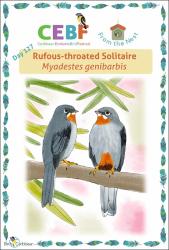| Abstract | Caribbean Endemic Bird Festival (CEBF) day 127 poster, dedicated to the Rufous-throated Solitaire (Myadestes genibarbis), a beloved songster of wet montane forests. It is found only on the following islands: Jamaica, Hispaniola, Dominica, Martinique, St. Lucia, and St. Vincent, each with its own subspecies. Across these islands this bird is more commonly heard than seen. It is always a delight to anyone on the trails to hear its melodic and hauntingly beautiful song. Its song consists of a series of clear and somewhat inharmonious flute-like whistled notes. The first note is low, second high, third low, interspersed with a ringing double note; or sometimes as “twuit, toi, tu-tu-tu-tu”. Calls include a single long “toot” like a distant car horn! You’ll find this bird hidden in the canopy of humid montane forests. If you’re lucky enough to see it, the first thing you’ll notice is its brilliant brick-red throat with overall gray plumage—slate-gray above and paler gray below. It has a white crescent below the eye, a white-flecked face, and whitish chin and mustache separated by a dark malar (stripe from the beak down the cheek). The lower belly and vent are tawny, bill black, and legs yellow. The sexes are similar. Juveniles are dark with orange-buff spots and streaks above. The Rufous-throated Solitaire forages up in the forest canopy, but it may occasionally feed in low vegetation. It feeds on small fruits and insects and travels alone or in mixed-species flocks. Insects are taken via aerial sallies, gleaning and hawking, and also by pouncing on insects on the ground from a perch. In the Dominican Republic and Jamaica it is a partial altitudinal migrant. It moves to lower altitudes in colder weather and ascends to the higher highlands as temperatures rise. The breeding season takes place from March to August in the DR and Jamaica, May in Haiti and May to July in the Eastern Caribbean. The nest is cup-shaped and usually placed in a crevice, creeper, in the center of a tree-fern or bromeliad, or tree hole. The female lays 2-3 eggs, bluish-white or blue with reddish-brown spots. As a complement to the poster, a coloring sheet is included. | es |



